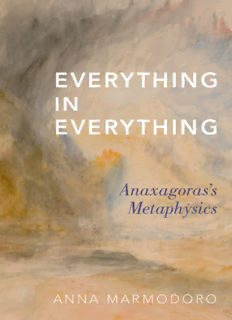
Everything in everything : Anaxagoras’s metaphysics PDF
Preview Everything in everything : Anaxagoras’s metaphysics
i EVERYTHING IN EVERYTHING ii iii EVERYTHING IN EVERYTHING Anaxagoras’s Metaphysics Anna Marmodoro 1 iv 1 Oxford University Press is a department of the University of Oxford. It furthers the University’s objective of excellence in research, scholarship, and education by publishing worldwide. Oxford is a registered trade mark of Oxford University Press in the UK and certain other countries. Published in the United States of America by Oxford University Press 198 Madison Avenue, New York, NY 10016, United States of America. © Oxford University Press 2017 All rights reserved. No part of this publication may be reproduced, stored in a retrieval system, or transmitted, in any form or by any means, without the prior permission in writing of Oxford University Press, or as expressly permitted by law, by license, or under terms agreed with the appropriate reproduction rights organization. Inquiries concerning reproduction outside the scope of the above should be sent to the Rights Department, Oxford University Press, at the address above. You must not circulate this work in any other form and you must impose this same condition on any acquirer. CIP data is on file at the Library of Congress ISBN 978– 0– 19– 061197– 2 1 3 5 7 9 8 6 4 2 Printed by Sheridan Books, Inc., United States of America v CONTENTS Acknowledgments ix Introduction 1 1. The Fundamental Items in the Ontology 11 1.1. Opposites, Stuffs, and Seeds 12 1.2. Does Matter “Matter” to Anaxagoras? 17 1.3. The Concreteness of Power 20 1.4. Parmenidean Constraints on Change 24 1.5. The Causal Efficacy of the Opposites 31 1.6. An Early Power Ontology? 38 1.7. Closing Remarks 42 1.A. Appendix: Anaxagorean versus Aristotelian Powers 43 2. The Principles Governing the Ontology 46 2.1. The Principle of Universal Extraction 48 2.2. The Everything- in- Everything Principle 51 2.3. The No- Least and No- Largest Principles 54 vi Contents 2.4. The Preponderance Principle: The Mechanism of Preponderance 60 2.5. The Outcome of Preponderance 66 2.6. Closing Remarks 73 3. A Theory of Extreme Mixture 74 3.1. The Inseparability of All Opposites 76 3.2. Power Gunk 84 3.3. Divided Gunk 88 3.4. Gunk’s Location in Space 90 3.5. The Grind Model 92 3.6. Can There Be Preponderance in a Gunky World? 96 3.7. Closing Remarks 100 3.A. Appendix: An Overview of Anaxagoras’s Main Metaphysical Principles 103 4. Compresence versus Containment of the Opposites 105 4.1. The Proportionate Interpretation 107 4.2. The Particulate Interpretation 109 4.3. The Liquids Model 113 4.4. The No- Divisibility Interpretation 121 4.5. Closing Remarks 125 4.A. Appendix: Zeno’s Argument from Multitude 127 5. Intelligent Powers 129 5.1. The Unmixed Status of Nous 131 5.2. The Structure and Operation of Nous 136 5.3. Nous’s Cosmic Powers 140 5.4. Nous’s Cognitive Powers 145 5.5. The Seeds and the Origins of Life 147 5.6. Closing Remarks 153 vi vii Contents 6. Stoic Gunk 156 6.1. Unlimited Division 158 6.2. Colocation 162 6.3. The Constitution of Material Bodies: What Is Active and What Is Passive 167 6.4. Sharing Subjects 174 6.5. Causation 177 6.6. Types of Ontological Unity 183 6.7. Closing Remarks 185 Conclusions 186 Bibliography 191 General Index 199 Index Locorum 213 vii viii ix ACKNOWLEDGMENTS This book project began in the summer of 2012, as part of my research program Power Structuralism in Ancient Ontologies, funded by the European Research Council (award number 63484). Throughout the years the project was ongoing, the two Oxford institutions to which I am affiliated, the Faculty of Philosophy and Corpus Christi College, provided me with an ideal research environment. I benefited from the opportunity to discuss my work in progress on multiple occasions here, and at a number of other universities in the United Kingdom, Europe, and the United States. I would like to thank collectively all the colleagues and students who engaged with my project and thus contributed to making this a better book. I am also very grateful to Patricia Curd and Stephen Makin, who served as readers for Oxford University Press and gave me insightful and helpful feedback on the typescript; and to Peter Ohlin, the Editor, for his support through- out. This book is dedicated to my friends, near and far, with thanks for their cheer and care. ix
Description: